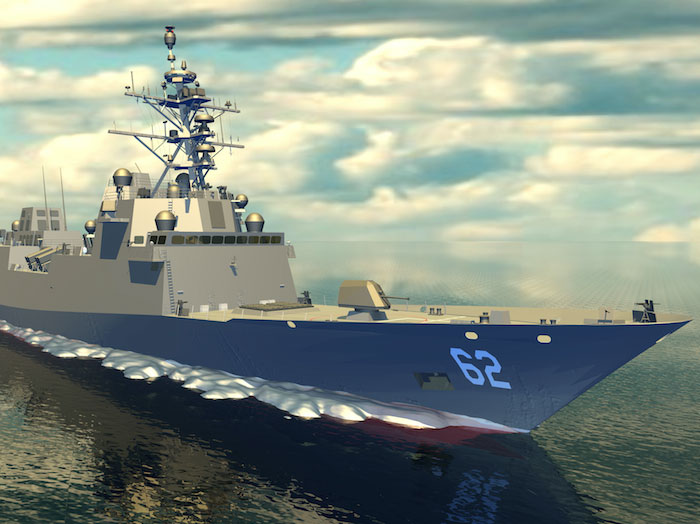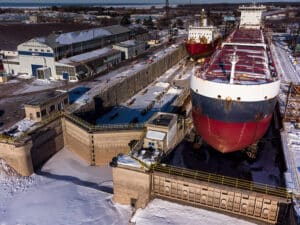
The Navy is U.S. shipbuilding’s largest customer
Written by Nick Blenkey
Image: Fincantieri
From the July issue of Marine Log magazine
There’s a reason why the larger U.S. shipbuilders have government relations offices, usually staffed up with a goodly number of retired U.S. Navy admirals. The U.S. government is the U.S. shipbuilding industry’s largest customer and the biggest part of the federal government’s shipyard spending is done by the Navy. A recent U.S. Maritime Administration report says that 78.7% of total 2019 revenues for the U.S. shipbuilding and repairing industry came from military shipbuilding and repairs.
So, not surprisingly the Navy’s annual budget request is always the focus of intense scrutiny—not least by Congressional committees. That’s happening right now and among the resources members of those committees, and their staffers, have available are Congressional Research Service (CRS) reports. As this was written, the CRS had just released its latest “Navy Force Structure and Shipbuilding Plans: Background and Issues for Congress” report.
How Many Ships?
Dated June 16, it notes that in December 2016, the Navy released a force-structure goal that calls for achieving and maintaining a fleet of 355 ships of certain types and numbers. Politicians like simple numbers like that and the 355-ship goal was made U.S. policy in the FY2018 National Defense Authorization Act. Until Congress changes, it striving for 355 ships is a legal requirement.
“The Navy and the Department of Defense (DoD) have been working since 2019 to develop a successor for the 355-ship force-level goal,” says the CRS report, ‘the new goal is expected to introduce a new, more distributed fleet architecture featuring a smaller proportion of larger ships, a larger proportion of smaller ships, and a new third tier of large unmanned vehicles (UVs).”
“On December 9, 2020,” continues the report, “the Trump administration released a document that can be viewed as its own vision for future Navy force structure. The document presents an envisioned Navy force-level goal for achieving by 2045 a Navy with a more distributed fleet architecture, including 382 to 446 manned ships and 143 to 242 large UVs. The Biden administration can choose to adopt, revise, or set aside this document.”
With the President Biden’s nominee for Secretary of the Navy yet to be confirmed, it can be assumed that things are not yet set in stone. All we know thus far is what’s in the Navy budget request. And what’s in a recent a “Report to Congress on the Annual Long-Range Plan for Construction of Naval Vessels for Fiscal Year 2022” a slender substitute for the long awaited complete 30-year shipbuilding plan. One is promised to accompany the President’s budget for FY2023.
“Meantime,” says the submission, “the Department is conducting analysis to refine understanding of the readiness and performance of the fleet against a future near-peer competitor capable of global operations. Furthermore, the DON continues to evaluate the industrial base pivot points required to support future platform development and the industrial base development needed for these future planned platforms, such as the next generation attack submarine (SSN(X)) and the future large surface combatant (DDG(X)), including land-based testing to enable success in these future programs.
Eight New Ships
The Navy’s proposed FY2022 budget requests the procurement of eight new ships, including two Virginia-class attack submarines (SSNs); one Arleigh Burke (DDG-51) class destroyer; one Constellation (FFG-62) class frigate; one John Lewis (TAO-205) class oiler; two TATS towing, salvage, and rescue ships; and one TAGOS(X) ocean surveillance ship.
The request for but a single Arleigh Burke is already getting push back.
In his opening remarks at a June 17 hearing on the Navy’s FY2022 request, House Armed Services Committee Chairman Rep. Adam Smith said that “on the concerning side of the budget request, I was disappointed to see a destroyer fall out of the budget and, thus, violate the current multi-year procurement contract the department has with the two shipbuilders. Multi-year contracts represent an agreement between Congress and the DoD that we will both stay committed to the fielding and funding of said weapon system. I have often said that I am not overly concerned with the numbers of ships we are striving to build but more about the capabilities those ships will bring to the fleet. The Flight III destroyer that fell out of this budget is the very capability that the Navy needs now and in the future … This committee will consider all options for restoring that destroyer in this year’s NDAA.”
Rep. Joe Courtney, Chairman of the House Subcommittee on Seapower and Projection Forces, echoed that concern.
“Just like last year,” he said, “we have a tough job ahead of us -this budget has some positive elements and it has some problems that we have to solve.”
“Once again, our panel is tasked with making sense of an unexpected reduction in steady rate production of one of our highest priority combatant vessel with the proposed reduction of one DDG-51 destroyer. I am deeply concerned that sudden course change threatens the stability of the industrial base, undermines confidence in multi-year procurement agreements, and threatens our ability to meet our defense strategy.
“At the same time, the budget proposes an increase in ship retirements—nearly double the number of new ship construction proposed—including an increase in the retirement of cruisers planned for modernization. Cruiser modernization is an issue that this subcommittee has grappled with for many, many years. I hope our witnesses today can provide more detailed insight into the analysis behind this proposal and how it fits into the Navy’s overall efforts to meet its operational requirements.
“Led by our subcommittee, Congress is clearly on record in bipartisan support of a 355-ship Navy due to the need to grow the fleet and capabilities needed. Whether it’s the fleet of 2022, 2032 or 2042, the fact remains that the investments we make today dictate the fleet we will have tomorrow. And that the fleet we have is aging and becoming more costly to operate while demands for Navy capabilities and presence are increasing.
“Whatever the ultimate goal is for the size of our fleet, the basic fundamentals of successful shipbuilding remain the same: stable and predictable requirements that industry can plan towards and rely on, steady rate production that facilitates effective workforce development and cost reduction, and an underlying long-term strategy that the Navy, Congress, and industry can work from.
“Too many recent budgets have fallen short of these fundamentals only to rely on Congress to fill the gaps. For example, this is the second year in a row, under two different administrations, that the Navy has presented a budget that removes a planned major combatant vessel only to list it as its top underfunded requirement. That is not a trend any of us here on this committee want to see continued into a third year.”




